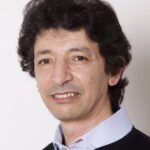Link to Pubmed [PMID] – 26754646
Link to HAL – pasteur-01317988
Link to DOI – 10.1083/jcb.201509017
Journal of Cell Biology, 2016, 212 (2), pp.231-44. ⟨10.1083/jcb.201509017⟩
The precise architecture of hair bundles, the arrays of mechanosensitive microvilli-like stereocilia crowning the auditory hair cells, is essential to hearing. Myosin IIIa, defective in the late-onset deafness form DFNB30, has been proposed to transport espin-1 to the tips of stereocilia, thereby promoting their elongation. We show that Myo3a(-/-)Myo3b(-/-) mice lacking myosin IIIa and myosin IIIb are profoundly deaf, whereas Myo3a-cKO Myo3b(-/-) mice lacking myosin IIIb and losing myosin IIIa postnatally have normal hearing. Myo3a(-/-)Myo3b(-/-) cochlear hair bundles display robust mechanoelectrical transduction currents with normal kinetics but show severe embryonic abnormalities whose features rapidly change. These include abnormally tall and numerous microvilli or stereocilia, ungraded stereocilia bundles, and bundle rounding and closure. Surprisingly, espin-1 is properly targeted to Myo3a(-/-)Myo3b(-/-) stereocilia tips. Our results uncover the critical role that class III myosins play redundantly in hair-bundle morphogenesis; they unexpectedly limit the elongation of stereocilia and of subsequently regressing microvilli, thus contributing to the early hair bundle shaping.



